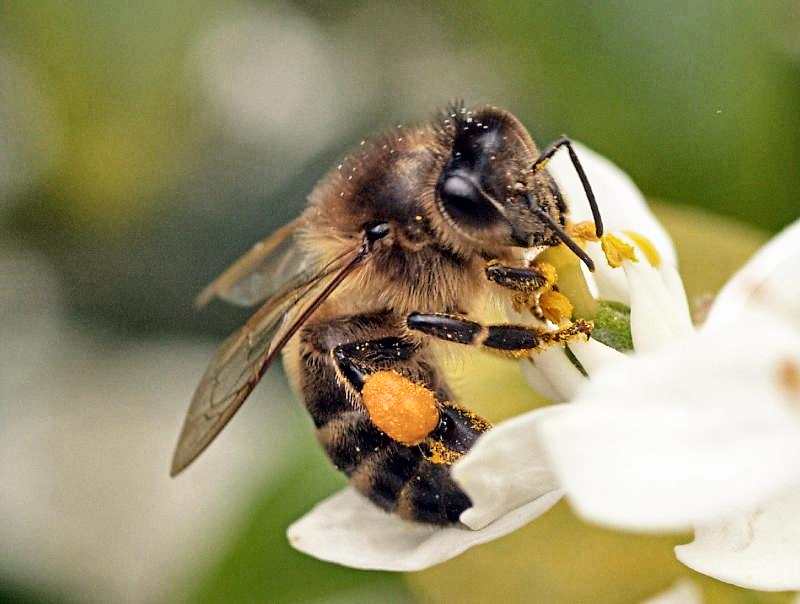
This Bee and all the other Bees keep us Alive... Oh yes they do! Bees are responsible for pollinating not just flowers, but the fruits, vegetables, & herbs we eat as well. If not for the Bees & the job of Pollination, we'd have nothing to eat except for GMO food-like-products.
So here's the problem:
Earthjustice
 GENUINE
CRISIS: Have you heard of colony collapse disorder (CCD)? Honeybees
have been suffering from CCD as a result of the widespread use of
neonicotinoid pesticides. This type of pesticide is used on 140
different crops, and very harmful to our primary pollinators. LISTEN TO
THE PODCAST to learn how Earthjustice is using the power of the law to
stop the EPA from approving more bee-killing pesticides.
GENUINE
CRISIS: Have you heard of colony collapse disorder (CCD)? Honeybees
have been suffering from CCD as a result of the widespread use of
neonicotinoid pesticides. This type of pesticide is used on 140
different crops, and very harmful to our primary pollinators. LISTEN TO
THE PODCAST to learn how Earthjustice is using the power of the law to
stop the EPA from approving more bee-killing pesticides. In this interview, Earthjustice attorney Greg Loarie discusses his efforts to get the toxic pesticide, sulfoxaflor, off of the market due to the threat it poses to honeybees.
https://soundcloud.com/earthjustice-down2earth/feeling-the-sting-toxic-pesticide-threatens-honeybees
Pesticide News Story: The EPA’s Final Decision on the New Active Ingredient: Sulfoxaflor
For Release: May 6, 2013The EPA has granted unconditional registrations for the new active ingredient sulfoxaflor, formulated as a manufacturing use product and two end-use products for use in production agriculture. The EPA is granting the use of sulfoxaflor on barley, bulb vegetables, canola, citrus, cotton, cucurbit vegetables, fruiting vegetables, leafy vegetables, low-growing berries, okra, ornamentals (herbaceous and woody), pistachio, pome fruits, root and tuber vegetables, small vine climbing fruit (except fuzzy kiwifruit), soybean, stone fruit, succulent, edible podded and dry beans, tree nuts, triticale, turfgrass, watercress and wheat.
Occupational worker and food safety data confirm these uses are safe when sulfoxaflor is used in accordance with the labeling terms and restrictions. Also, the ecological effects profile for sulfoxaflor supports the registration finding. One area of focus in the review involved pollinator health, and the final label includes robust terms for protecting pollinators. The EPA performed its data evaluation and assessments in collaboration with its counterpart agencies in Canada and Australia. Scientists from the three authorities reviewed over 400 studies and peer reviewed each other’s work.
 The registration will provide growers with a new pest management
tool for use on piercing/sucking insects. Sulfoxaflor has been used
under an emergency clearance on cotton in Arkansas, Mississippi,
Tennessee and Louisiana to control the tarnished plant bug, an insect
that has developed resistance to alternative registered pesticides.
Sulfoxaflor belongs to its own new insecticide subclass in terms of its
mode of action, so it is expected to be used by producers faced with
pests that have developed resistance to other alternatives.
The registration will provide growers with a new pest management
tool for use on piercing/sucking insects. Sulfoxaflor has been used
under an emergency clearance on cotton in Arkansas, Mississippi,
Tennessee and Louisiana to control the tarnished plant bug, an insect
that has developed resistance to alternative registered pesticides.
Sulfoxaflor belongs to its own new insecticide subclass in terms of its
mode of action, so it is expected to be used by producers faced with
pests that have developed resistance to other alternatives.For additional information please refer to the docket EPA-HQ-OPP-2010-0889 at the Federal e-Rulemaking Portal: http://www.regulations.gov.
Sulfoxaflor 
http://en.wikipedia.org/wiki/Sulfoxaflor
From Wikipedia, the free encyclopedia
| Sulfoxaflor | |||
|---|---|---|---|
 |
|||
| Identifiers | |||
| CAS number | 946578-00-3 |
||
| Properties | |||
| Molecular formula | C10H10F3N3OS | ||
| Molar mass | 277.27 g mol−1 | ||
| Except where noted otherwise, data are given for materials in their standard state (at 25 °C (77 °F), 100 kPa) | |||
| Infobox references | |||
Sulfoxaflor is a systemic insecticide which acts as an insect neurotoxin and is the only member a class of chemicals called the sulfoximines which act on the central nervous system of insects with much lower toxicity to mammals very similarly to neonicotinoids. The chemical works by interfering with the transmission of stimuli in the insect nervous system. Specifically, it causes a blockage in the nicotinergic neuronal pathway.[1] This blockage leads to the accumulation of acetylcholine, an important neurotransmitter, resulting in the insect's paralysis, and eventually death. It is effective on contact and via stomach action. Because sulfoxaflor binds much more strongly to insect neuron receptors than to mammal neuron receptors, this insecticide is selectively more toxic to insects than mammals.[2]
On May 6, 2013, the United States Environmental Protection Agency approved the first two commercial pesticide products that contain sulfoxaflor, marketed under the brand names "Transform" and "Closer", to the Dow Chemical Corporation. This pesticide has been registered to South Korea, Panama, Vietnam, Indonesia, and Guatemala and additional global registrations are expected in the near future.
See also
References
- Jump up ^ Cutler, P.; Slater, R.; Edmunds, A. J.; Maienfisch, P.; Hall, R. G.; Earley, F. G.; Pitterna, T.; Pal, S.; Paul, V. L.; Goodchild, J.; Blacker, M.; Hagmann, L.; Crossthwaite, A. J. (2013). "Investigating the mode of action of sulfoxaflor: A fourth-generation neonicotinoid". Pest Management Science 69 (5): 607–619. doi:10.1002/ps.3413. PMID 23112103.
- Jump up ^ "sulfoxaflor". ChemSpider. Royal Society of Chemistry. Retrieved 19 August 2013.
External links
- The EPA’s Final Decision on the New Active Ingredient Sulfoxaflor
- [1]
- [Dow AgroSciences Receives U.S. EPA Registration for Sulfoxaflor]
http://www.croplife.com/crop-inputs/insecticides/beekeeping-industry-files-appeal-against-epa-for-full-registration-of-sulfoxaflor/
http://www.govexec.com/management/2013/12/new-suspect-bee-deaths-us-government/76004/?oref=dropdown


























No comments:
Post a Comment